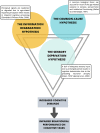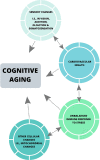Time for a Systems Biological Approach to Cognitive Aging?-A Critical Review
- PMID: 32477097
- PMCID: PMC7236912
- DOI: 10.3389/fnagi.2020.00114
Time for a Systems Biological Approach to Cognitive Aging?-A Critical Review
Abstract
The underlying premise of current theories of cognitive decline with age tend to be primarily cognitive or biological explanations, with relatively few theories adequately integrating both aspects. Though literature has also emphasized the importance of several factors that contribute to cognitive aging including: (a) decline in sensory abilities; (b) the effect of motor speed on paper-pencil measures of cognitive speed; (c) the impact of level of education and physical activity; and (d) molecular biological changes that occur with age, these factors have seldom been implicated into any single theoretical model of cognitive aging. Indeed, such an integrated bio-cognitive model of aging has the potential to provide a more comprehensive understanding of attention, perception, learning, and memory across the lifespan. Thus, the aim of this review was to critically evaluate common theories of age-related cognitive decline and highlight the need for a more comprehensive systems neuroscience approach to cognitive aging.
Keywords: biological aging; cardiovascular health; cognitive aging; cognitive decline; systems neuroscience; theories of aging.
Copyright © 2020 Ebaid and Crewther.
Figures
Similar articles
-
Enrichment Effects on Adult Cognitive Development: Can the Functional Capacity of Older Adults Be Preserved and Enhanced?Psychol Sci Public Interest. 2008 Oct;9(1):1-65. doi: 10.1111/j.1539-6053.2009.01034.x. Epub 2008 Oct 1. Psychol Sci Public Interest. 2008. PMID: 26162004
-
Cognitive Processing Speed across the Lifespan: Beyond the Influence of Motor Speed.Front Aging Neurosci. 2017 Mar 22;9:62. doi: 10.3389/fnagi.2017.00062. eCollection 2017. Front Aging Neurosci. 2017. PMID: 28381999 Free PMC article.
-
The impact of aging on cognitive functions. An 11 year follow-up study of four age cohorts.Acta Neurol Scand Suppl. 1997;172:7-86. Acta Neurol Scand Suppl. 1997. PMID: 9469200
-
The relationship between Big-5 personality traits and cognitive ability in older adults - a review.Neuropsychol Dev Cogn B Aging Neuropsychol Cogn. 2015;22(1):42-71. doi: 10.1080/13825585.2014.888392. Epub 2014 Feb 28. Neuropsychol Dev Cogn B Aging Neuropsychol Cogn. 2015. PMID: 24580119 Review.
-
The knowledge domain of cognitive neuroscience of aging: A Scientometric and bibliometric analysis.Front Aging Neurosci. 2023 Feb 9;15:999594. doi: 10.3389/fnagi.2023.999594. eCollection 2023. Front Aging Neurosci. 2023. PMID: 36845653 Free PMC article. Review.
Cited by
-
Spatial selective auditory attention is preserved in older age but is degraded by peripheral hearing loss.Sci Rep. 2024 Oct 31;14(1):26243. doi: 10.1038/s41598-024-77102-5. Sci Rep. 2024. PMID: 39482327 Free PMC article.
-
Asymmetries and hemispheric interaction in the auditory system of elderly people.Front Neuroimaging. 2024 Jan 3;2:1320989. doi: 10.3389/fnimg.2023.1320989. eCollection 2023. Front Neuroimaging. 2024. PMID: 38235106 Free PMC article. Review.
-
Musicianship-Related Structural and Functional Cortical Features Are Preserved in Elderly Musicians.Front Aging Neurosci. 2022 Mar 25;14:807971. doi: 10.3389/fnagi.2022.807971. eCollection 2022. Front Aging Neurosci. 2022. PMID: 35401149 Free PMC article.
-
Improving Sleep Quality and Well-Being in Institutionalized Older Adults: The Potential of NESA Non-Invasive Neuromodulation Treatment.Geriatrics (Basel). 2025 Jan 3;10(1):4. doi: 10.3390/geriatrics10010004. Geriatrics (Basel). 2025. PMID: 39846574 Free PMC article.
-
Intrinsic capacity and health-promoting lifestyle in older adults: a latent class analysis.Front Public Health. 2025 Jul 16;13:1634373. doi: 10.3389/fpubh.2025.1634373. eCollection 2025. Front Public Health. 2025. PMID: 40740367 Free PMC article.
References
-
- Aalto S., Brück A., Laine M., Någren K., Rinne J. O. (2005). Frontal and temporal dopamine release during working memory and attention tasks in healthy humans: a positron emission tomography study using the high-affinity dopamine D2 receptor ligand [11C] FLB 457. J. Neurosci. 25, 2471–2477. 10.1523/jneurosci.2097-04.2005 - DOI - PMC - PubMed
LinkOut - more resources
Full Text Sources



